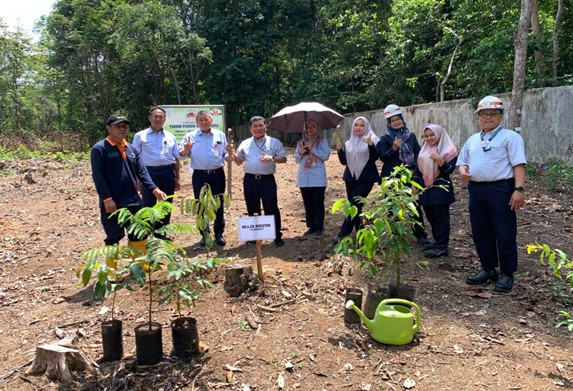
SYMBOLIC TREE PLANTING IN THE BIODIVERSITY AREA OF TEL
A brief ceremony of Productive Tree Planting was carried out the Biodiversity Garden (KEHATI) area PT. Tanjungenim Lestari Pulp and Pap PT TeL) on November 13, 2024. Symbolically, the joint planting activity was carried out by the HR&CA Director, General Mill Manager, and PROPER Coordinator accompanied by the KEHATI team, Deputy Head of Corporate Affairs Division, Deputy Head of Production Division and the General Affairs team of PT TeL. This is the commitment of PT TeL to support the sustainable Biodiversity Conservation Program.
The HR&CA Director (Mr. M. Amrodji) appreciated the implementation of the KEHATI program in order to create a sustainable green environment and later be able to reduce carbon emissions in the TeL Area.
The tree planting activity is one of the implementations of the KEHATI program to support Green PROPER-TeL and in efforts to save, and preserve the environment and for the long term as a program to empower the surrounding community while supporting environmental conservation and greening efforts. All plants/trees planted such as fruit tree seedlings, local/endemic tree seedlings and Mahogany tree seedlings come from the Nursery program which is sown from superior and good quality seeds that have been prepared in advance by the KEHATI (Biodiversity Team) Tel.
The types of plants/tree seedlings that are planted sustainably are as follows:
- Fruit trees/plants and flower plants (Fruit Garden Lestari)
Types of plants such as Durian, Matoa, Avocado, Longan, Duku, Mangosteen, Jackfruit and other superior types/varieties will be planted in the Fruit Garden Lestari area (Fruit Garden and Flower Garden) covering an area of 1 (one) Hectare at the KEHATI TeL location.
Long-term benefits of fruit plants: Food Source for Fauna Diversity, especially rare and protected animals (Conservation status P.LHK.106 – IUCN Red list) such as the habitat of the Yellow Cucak Bird (Aves) conservation type, Gray Langur with long black body and tail hair (Trachypithecus Chistatus), Raja Mela Butterfly (Troides amphrysus) and from the Hesperiidae, Amphibian and Reptile (Herpetofauna) families and 0ther mammal species. While one of the long-term goals is Education, Conservation, fruit garden tourism and Empowerment of the surrounding community. - Local trees/plants (endemic)
Types of plant nurseries (IUCN Redlist) such as Asam Kandis, Jeluak, Sungkai, Puspa/Seru, Palangas Keliat and other varieties will be planted in the KEHATI Park area.
Long-term benefits of local/endemic plants: Preservation of the biodiversity of local/endemic plant flora. Planting/multiplying endemic trees, has contributed to preserving nature and preventing climate change and can produce oxygen, also has an important role in maintaining water absorption and availability. - Mahogany Tree/Plant
Additionality TeL Company’s commitment to environmental management is more than what is required/obligated by regulations (Beyond Compliance).
Planting of Mahogany seedlings will be carried out in the KEHATI garden area, the area around the Holding-pond, Landfill, the Company’s land boundaries and in other areas in the PT TeL Area.
Long-term benefits of Mahogany plants: Green Environment reducing sustainable Carbon emissions (environmental Greening) L Referring to several sources of research results from experts Agriculture, Plantation and Forestry published in several scientist journals, it shows that mahogany trees are a type of tree that has a very high carbon dioxide absorption capacity.
Mahogany trees can provide positive contributions in reducing global warming and improving air quality (reducing air pollution by around 4769%). Because mahogany trees are able to absorb carbon and produce very high oxygen. Mahogany trees can absorb up to 955.73 kilograms of carbon dioxide per year.


